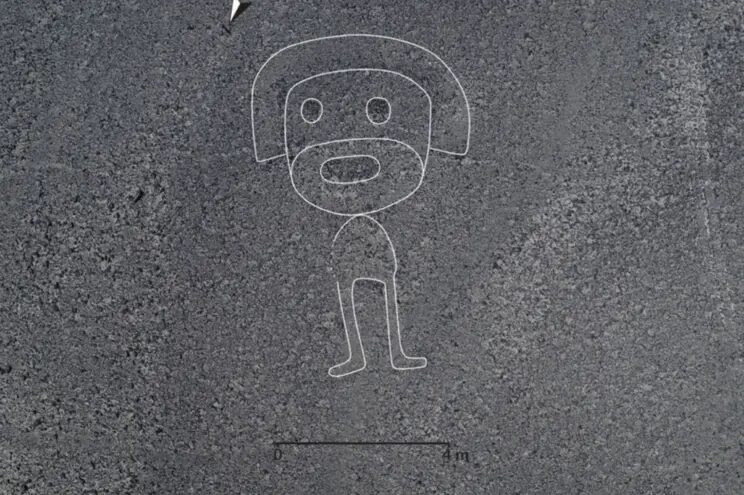
© Yamagata UniversityAbout 50 of the large-scale drawings are of human-like figures
Scientists have discovered 168 new geoglyphs in the soil of Peru's desert — almost doubling the known instances of ancient Nazca Lines in the area.
Peruvian and Japanese researchers from Yamagata University spent two years scanning the UNESCO World Heritage site on Peru's southern Pacific coast using aerial photos, drones and field surveys.
The drawings portray humans, camelids, birds, killer whales, felines, snakes and more. About 50 of the large-scale drawings are of human-like figures — with one even resembling Homer Simpson.
While it's hard to know exactly when the geoglyphs were made, clay pots found near the lines point to a time between 100 B.C. and 300 A.D. — between 2,100 and 1,700 years ago.Most of the Nazca Lines can only be seen from the air, and have mystified scientists for years. But
the recently discovered figures are smaller, averaging between 6 feet and 19 feet in length, and can be seen from the ground, Masato Sakai, a professor from Yamagata University who led the study, told
Reuters.
"
These geoglyphs were created by removing black stones from the surface of the earth to expose a white sandy surface below,"
a statement from Yamagata University said.
Some information currently being gathered by the researchers will be analyzed by artificial intelligence programs, which will be able to depict patterns more quickly and effectively than the human eye and inform the lines' preservation.
By 2019, archaeologists had discovered a total of nearly 200 geoglyphs in the area.
These new drawings bring the official number of known Nazca Lines to 358.An archaeologist previously told the Guardian that he believed scientists had only found 5% of all the Nazca Lines out there.The scientists at Yamagata had been granted permission from Peru's Ministry of Culture to tally as many of the geoglyphs as possible, planning to map out the entire length and width of the desert canvas.
An archeological park to protect the geoglyphs was established in the Aja area near the downtown of Nasca City in 2017.
"As many as 36 of these geoglyphs were discovered in the Aja area, near the city of Nasca. The discovery of 41 geoglyphs in this area was previously announced by Yamagata University in 2014 and 2015, which led to the creation of an archaeological park in 2017 in collaboration with the Peruvian Ministry of Culture to protect them. With this discovery, a total of 77 geoglyphs are now known to be concentrated in this archaeological park," the statement from Yamagata University said.
The purpose of the Nazca Lines still remains unknown, according to Nazca Lines research program's head archaeologist, Jorge Olano.
Despite being mysterious, they have been interpreted in many ways, including that they're meant for gods in the sky or that they're supposed to reflect the stars for astronomical purposes.

Reader Comments
[Link]
...and good eye on ya danny esq !
Best wishes to you Ukigigi!
Ken
It just looks like the scratching upon a blackboard a kid would make after playing a video game.
It seems fake.
The lines too smooth - they don't seem aged....the image obvious seems modern in presentation.
Oh well, it is what it is, and the solstice it has happened!
In 2023, those determined I suspect will force the truth to be revealed and then....
let the chips fall where they will.
BK
I'd be happy to be proven wrong, and rumor I've heard is visits from afar have been more common in Peru then elsewhere, but still, intuitively, this image seems to be fakery.
To try to expound on my intuition, I think the shapes and the contours seem almost "too modern" - like the Jetsons or some such.
I think it is a complete fake - like so much these days I reckon.
Another possibility, the image above seems to say it is 4 m (meters?) in width, could it be some Peruvian miscreant just scratched it in in order to give the scientist some of their own medicine of misinterpretation?
Ken
Lol - complete bravo sierra.
Are currently thought to be directional Ley lines, geometrical directional markers for water sources, springs. Totemic animal spirits (semiotic geoglyphs) nothing new just slightly different to specie variations etc.
Nazca Face Vessels [Link]
Academia trying desperately to align with the narratives but it will not be able to in the end. Truth will prevail.
The technique of infamy is to start two lies at once and get people arguing heatedly over which is the truth.
Lol - complete bravo sierra.
Nazca lines are currently thought to be directional Ley lines, geometrical directional markers for water sources, springs. Totemic animal spirits (semiotic geoglyphs) nothing new just slightly different to specie variations etc. Nazca culture had knowledge & knew about Cosmogony/Cosmotheology/Astrology. Warrior stewards of the Sun & Venus worship.
Nazca Face Vessels [Link]
Academia trying desperately to align with the narratives but it will not be able to in the end. Truth will prevail.
The technique of infamy is to start two lies at once and get people arguing heatedly over which is the truth.